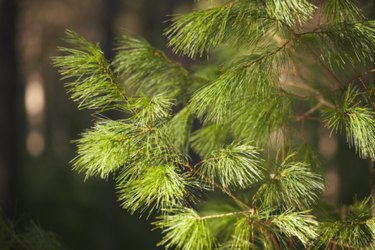
Among the most popular of landscaping trees, evergreens provide greenery in the garden throughout the year. When choosing evergreens, consider their rate of growth and how it affects your landscaping plans. The University of Minnesota Extension recommends using the fewest varieties of evergreens and selecting them for a specific purpose. If used for screening, slower-growing evergreen trees may not be suitable as they take too long to mature to their full height.
Firs
Video of the Day
The slow-growing balsam fir Abies balsamea reaches a height of approximately 50 feet. Suitable for full or partial sun, it grows in a pyramidal shape. Abies concolor, the white fir, boasts gray or blue needles and tops out between 35 and 50 feet. While it can tolerate partial shade, it needs moist, well-drained soil.
Video of the Day
Pine Trees
Many pine trees grow slowly. Among them are Pinus mugo, known as mugo pine and the Swiss mountain pine, which is often sold in dwarf form. This dark-green needled pine can tolerate partial shade. Also a slow-grower is Pinus parviflora, or the Japanese white pine. Recommended for small areas, this salt-tolerant pine reaches 25 to 50 feet in height and a similar width at maturity. Pinus bungeana, the lacebark pine, grows slowly, reaching between 30 and 50 feet high when full grown. As it ages, it changes in shape from pyramidal to a broader spread.
Spruces
Many spruce varieties are slow growing. These include the dwarf Alberta spruce, which grows only 2 to 4 inches per year, reaching 10 to 12 feet in height at maturity around age 25. Picea omorika, or the Serbian spruce, is a slow-growing, attractive specimen tree, reaching an eventual height between 50 and 60 feet. The Black Hills spruce, Picea glauca, grows up to 40 feet in a pyramidal shape. Plant in full sun.
Arborvitae
All arborvitae varieties need full sun and moist, well-drained soils. The slowest growing of these trees is Thuja occidentalis, also known as the American or eastern arborvitae or the white cedar, which tops out at 30 feet tall. Thuja plicata, or giant arborvitae, is slow growing but often used for screening, as it can reach up to 70 feet at maturity.